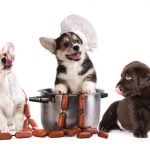
Pet owners are a funny breed in many ways. I’m one ! Ask them about their animal and four out of five pet owners will say their pet is a member of the family. About 80 per cent think that pet food should be as good a quality as their own. Pet food and their care is a growth arena. In 2017 according to Nielsen, consumers spent $20 billion on looking after their pets besides just feeding them.
A bigger chunk was spent on food. So, when you hear that the premium sector for pet food was 45% of the $29 billion dollar USA pet food market in 2017 then it’s not surprising. Further, the superpremium content was just under 10 per cent. Nielsen tell us $10 billion was spent on dog food alone in 2017. Current projections suggest the pet food sales will make $33 Billion in 2018 according to the market research publisher Packaged Foods in Pet Food in the US., 11th Edition.
In the USA and United Kingdom, more households have dogs than children – it works out at 42% versus 30% with 25% having a cat or 11 per cent having both a dog with a cat. These stats haven’t changed much since 2014 when the statistics were first reported. It all means that the pet food category is a growing area for product development whilst the more traditional packaged food categories for humans slows down a bit.
In terms of food for pets, there has been an explosion of different types of food. Gourmet packs come with descriptions which outdo some of the cordon bleu menus of top restaurants. Indeed, the descriptions used are mouth watering for humans let alone any animal that might read it. The options are unlimited in truth. Treats have grown a fair bit mainly with dog owners. Cat owners are less seduced by the offerings in the pet food industry although in 2016 there was a surge in gourmet style for pussies.
Nowadays, on-line pet food sales are exceeding purchases from retailers.
Large food manufacturers are also seeking a large slice of the pet food business. Take General Mills for example which has stomped up $8 billion cash to purchase Blue Buffalo Pet Products. It should complete purchase by the end of 2018. The M & M owner, Mars has built a considerable pet food business over many years, which now includes Iams, Pedigree and Whiskas brands. These brands protect it from a slow down in confectionary sales (CNBC, 2018). The jam owner, JT Smucker bought the pet food company Big Heart Pet Brands for $6 billion in 2015 which established it in the pet food industry.
Cargill has also reached an agreement to but Pro-Pet which is the Ohio-based manufacturer of private label and co-manufactured pet foods. The brands include the premium dog food brand Black Gold. This acquisition at the beginning of 2018 makes Cargill the only national supplier of both animal feed and pet food offerings in the agricultural retail space. Cargill has 50 animal feed production and distribution facilities across the USA. These provide branded and private label pet food to agricultural retailer customers.
Nestlé has large manufacturing facilities in Brazil.
Pet food doesn’t come without its issues. One which bedevils human food as well as pet food is contamination from drugs or from food poisoning organisms. In February 2018, the US Food & Drug Administration has recalled two pet products for Salmonella contamination. Smokehouse Pet products has recalled various lots of Beefy Munchies sold in 4-oz bags. These were sold in a few states through a distribution network to a number of retailers. It was the routine sampling by the Colorado Dept. of Agriculture that revealed the presence of Salmonella in two packages of the product.
It’s worth commenting that Salmonella affects both people and animals. There is a risk to humans from handling contaminated pet products. Risk of infections comes from not thorough washing of hands having contacted products are surfaces exposed to these products. The US FDA state in their recall notice that:-
“Healthy people infected with Salmonella should monitor themselves for some or all of the following symptoms: nausea, vomiting, diarrhea or bloody diarrhea, abdominal cramping and fever.
Rarely, Salmonella can result in more serious ailments, including arterial infections, endocarditis, arthritis, muscle pain, eye irritation, and urinary tract symptoms. Consumers exhibiting these signs after having contact with this product should contact their healthcare providers.”
“Pets with Salmonella infections may be lethargic and have diarrhea or bloody diarrhea, fever, and vomiting. Some pets will have only decreased appetite, fever and abdominal pain. Infected but otherwise healthy pets can be carriers and infect other animals or humans.”
The second recall was issued for Raws for Paws for 4,000 lbs of Ground Turkey Pet Food available in chubs which are 1-lb and 5-lb plastic sealed tubes. The Minnesota Depts. of Health (MDH) and Agriculture (MDA) are investigating two cases of Salmonella Reading infection this February (2018) with the same DNA fingerprint pattern. The cases concern children in the Twin Cities metro area who became ill after raw ground turkey food for pets was fed to pets in their home. One child’s infection resulted in osteomyelitis, a painful and serious bone infection.
The other issue has been the appearance of the Euthanasia drug, pentobarbital. The levels are so low as to not pose a threat to animal or man. However, it raises questions about control of the supply chain.
This page contains links to our affiliate marketing partner. Please read our affiliate disclosure.

Leave a Reply